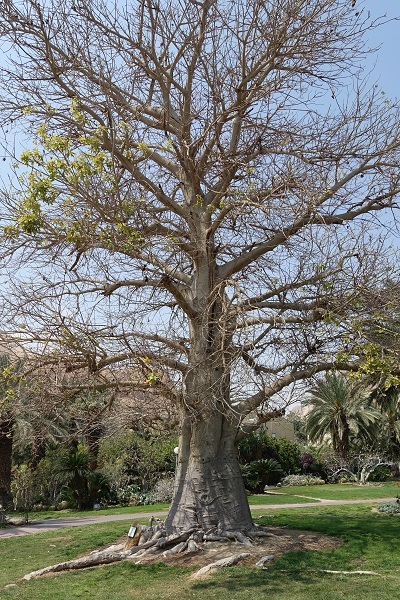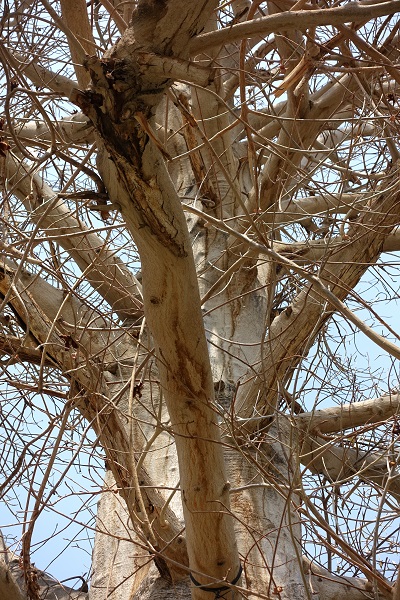Hebrew: עץ הבאובב , אדנסוניה מאוצבעת, Arabic: تبلدي إصبعي
| Scientific name: | Adansonia digitata L. | |
| Synonym name: | Adansonia bahobab L. | |
| Common name: | African baobab, Upside-down Tree | |
| Hebrew name: | עץ הבאובב , אדנסוניה מאוצבעת | |
| Arabic name: | تبلدي إصبعي | |
| Family: | Malvaceae, Mallow Family, משפחה חלמיתיים |

|
| Life form: | Deciduous tree | |
| Stems: | Trunk that can grow to an immense girth. Bark is smooth, reddish brown to grey. | |
| Leaves: | Borne at the ends of branches, leaves are usually divided into 5‒7 leaflets attached to a central point. | |
| Inflorescence: | A single flower, situated in the axils of leaves near the tips of reproductive branches. | |
| Flowers: | Large (up to 20 cm in diameter), white and pendent on long stalks. Each flower has five free petals and many stamens (male parts). The flowers open only at night and are pollinated by bats feeding on the nectar. | |
| Fruits / pods: | More or less cylindrical and up to 35 cm long and 13 cm wide. Each fruit is filled with mealy pulp containing many small, dark brown seeds, each about 1 cm long and wide. The seeds have a reddish-black seed coat. | |
| Habitat: | Savannah, and is also present in human habitation. | |
| Distribution: | Ein Gedi | |
| Chorotype: | Africa |

Derivation of the botanical name: Adansonia , named in honor of Michel Adanson (1727 - 1806), a French botanist. digitata, lobed like fingers.shaped like an open hand. baobab is derived from Arabic بو حِباب (būħibāb), which means "father of many seeds".
The Little Prince, first published in April 1943, is a novella. Styled as a children's book, The Little Prince makes several observations about life and human nature. The book is the most famous work of French aristocrat, writer, poet, and pioneering aviator Antoine de Saint-Exupéry. Chapter 5: "Now there were some terrible seeds on the planet that was the home of the little prince; and these were the seeds of the baobab. The soil of that planet was infested with them. A baobab is something you will never, never be able to get rid of if you attend to it too late. It spreads over the entire planet. It bores clear through it with its roots. And if the planet is too small, and the baobabs are too many, they split it in pieces..." The author ends with a warning: "Children, watch out for the baobabs!" |